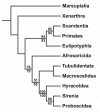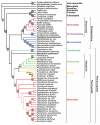A new estimate of afrotherian phylogeny based on simultaneous analysis of genomic, morphological, and fossil evidence
- PMID: 17999766
- PMCID: PMC2248600
- DOI: 10.1186/1471-2148-7-224
A new estimate of afrotherian phylogeny based on simultaneous analysis of genomic, morphological, and fossil evidence
Abstract
Background: The placental mammalian clade Afrotheria is now supported by diverse forms of genomic data, but interordinal relationships within, and morphological support for, the group remains elusive. As a means for addressing these outstanding problems, competing hypotheses of afrotherian interordinal relationships were tested through simultaneous parsimony analysis of a large data set (> 4,590 parsimony informative characters) containing genomic data (> 17 kb of nucleotide data, chromosomal associations, and retroposons) and 400 morphological characters scored across 16 extant and 35 extinct afrotherians.
Results: Parsimony analysis of extant taxa alone recovered the interordinal topology (Afrosoricida, ((Macroscelidea, Tubulidentata), (Hyracoidea, (Proboscidea, Sirenia)))). Analysis following addition of extinct taxa instead supported Afroinsectivora (Afrosoricida + Macroscelidea) and Pseudoungulata (Tubulidentata + Paenungulata), as well as Tethytheria (Proboscidea + Sirenia). This latter topology is, however, sensitive to taxon deletion and different placements of the placental root, and numerous alternative interordinal arrangements within Afrotheria could not be statistically rejected. Relationships among extinct stem members of each afrotherian clade were more stable, but one alleged stem macroscelidean (Herodotius) never grouped with that clade and instead consistently joined pseudoungulates or paenungulates. When character transformations were optimized onto a less resolved afrotherian tree that reflects uncertainty about the group's interordinal phylogeny, a total of 21 morphological features were identified as possible synapomorphies of crown Afrotheria, 9 of which optimized unambiguously across all character treatments and optimization methods.
Conclusion: Instability in afrotherian interordinal phylogeny presumably reflects rapid divergences during two pulses of cladogenesis - the first in the Late Cretaceous, at and just after the origin of crown Afrotheria, and the second in the early Cenozoic, with the origin of crown Paenungulata. Morphological evidence for divergences during these two pulses either never existed or has largely been "erased" by subsequent evolution along long ordinal branches. There may, nevertheless, be more morphological character support for crown Afrotheria than is currently assumed; the features identified here as possible afrotherian synapomorphies can be further scrutinized through future phylogenetic analyses with broader taxon sampling, as well as recovery of primitive fossil afrotherians from the Afro-Arabian landmass, where the group is likely to have first diversified.
Figures


Similar articles
-
Phylogenomics of Afrotherian mammals and improved resolution of extant Paenungulata.Mol Phylogenet Evol. 2024 Jun;195:108047. doi: 10.1016/j.ympev.2024.108047. Epub 2024 Mar 7. Mol Phylogenet Evol. 2024. PMID: 38460890
-
Interordinal mammalian relationships: evidence for paenungulate monophyly is provided by complete mitochondrial 12S rRNA sequences.Mol Phylogenet Evol. 1996 Oct;6(2):245-58. doi: 10.1006/mpev.1996.0074. Mol Phylogenet Evol. 1996. PMID: 8899726
-
Ocepeia (Middle Paleocene of Morocco): the oldest skull of an afrotherian mammal.PLoS One. 2014 Feb 26;9(2):e89739. doi: 10.1371/journal.pone.0089739. eCollection 2014. PLoS One. 2014. PMID: 24587000 Free PMC article.
-
The chromosomes of Afrotheria and their bearing on mammalian genome evolution.Cytogenet Genome Res. 2012;137(2-4):144-53. doi: 10.1159/000341387. Epub 2012 Aug 3. Cytogenet Genome Res. 2012. PMID: 22868637 Review.
-
Early tetrapod relationships revisited.Biol Rev Camb Philos Soc. 2003 May;78(2):251-345. doi: 10.1017/s1464793102006103. Biol Rev Camb Philos Soc. 2003. PMID: 12803423 Review.
Cited by
-
Stable isotope evidence for an amphibious phase in early proboscidean evolution.Proc Natl Acad Sci U S A. 2008 Apr 15;105(15):5786-91. doi: 10.1073/pnas.0800884105. Epub 2008 Apr 14. Proc Natl Acad Sci U S A. 2008. PMID: 18413605 Free PMC article.
-
Phylogenomics reveals an almost perfect polytomy among the almost ungulates (Paenungulata).bioRxiv [Preprint]. 2023 Dec 8:2023.12.07.570590. doi: 10.1101/2023.12.07.570590. bioRxiv. 2023. PMID: 38106080 Free PMC article. Preprint.
-
Evolutionary history of the grey-faced Sengi, Rhynchocyon udzungwensis, from Tanzania: a molecular and species distribution modelling approach.PLoS One. 2013 Aug 27;8(8):e72506. doi: 10.1371/journal.pone.0072506. eCollection 2013. PLoS One. 2013. PMID: 24015252 Free PMC article.
-
A phylogenetic estimate for golden moles (Mammalia, Afrotheria, Chrysochloridae).BMC Evol Biol. 2010 Mar 9;10:69. doi: 10.1186/1471-2148-10-69. BMC Evol Biol. 2010. PMID: 20214773 Free PMC article.
-
A supermatrix analysis of genomic, morphological, and paleontological data from crown Cetacea.BMC Evol Biol. 2011 Apr 25;11:112. doi: 10.1186/1471-2148-11-112. BMC Evol Biol. 2011. PMID: 21518443 Free PMC article.
References
Publication types
MeSH terms
LinkOut - more resources
Full Text Sources
Research Materials

